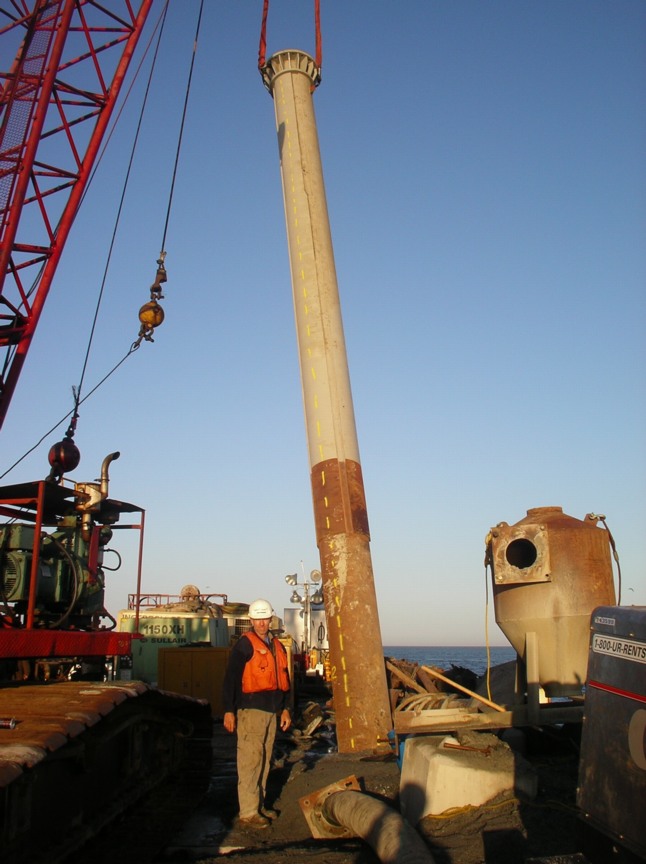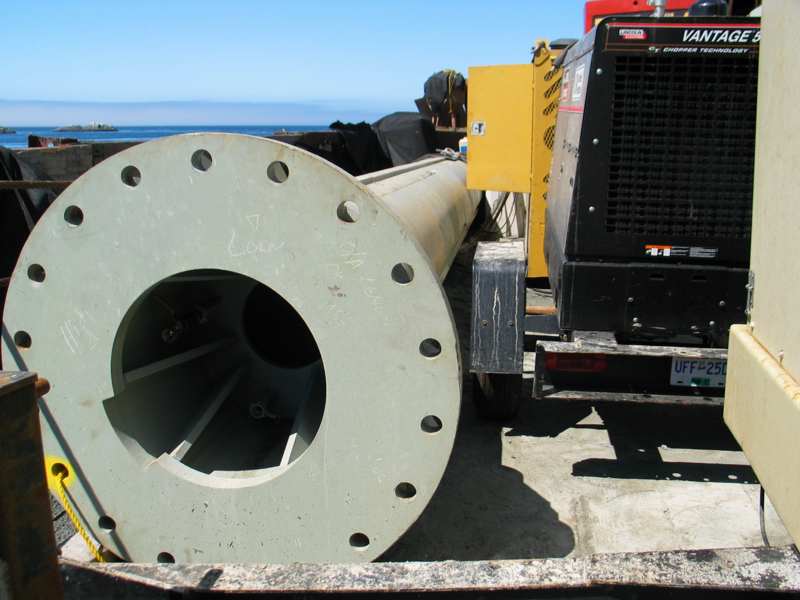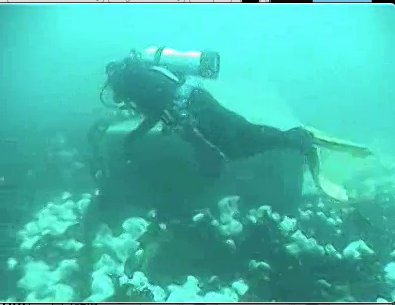
The crane hoists it into position. Almost half of it will be sunk in the shaft drilled underground at 20 meters depth
Images by Garry Fletcher and Gary Bouman
With the Pearson College – EnCana – Clean Current Tidal Power Demonstration Project at Race Rocks now fully underway, we are seeing a variety of activities in the preparation for the tidal generator and other components of the Integrated Energy System at Race Rocks. Look for the most recent updates at the top of this page.
 END of Tidal Energy project and removal of Turbine
END of Tidal Energy project and removal of Turbine
In the late summer of 2009, Pearson College installed six new 165 watt solar panels to add to the existing bank of 38 panels on the energy centre.
 Redeployment of the Tidal Energy Turbine October 2008
Redeployment of the Tidal Energy Turbine October 2008
April, 2007.The tidal energy turbine is raised to change the bearings which had been deteriorating faster than expected.
 Cementing anchor bolts to the roof January 17, 2007
Cementing anchor bolts to the roof January 17, 2007
Installaton of solar panels January 25,2007
 PM Stephen Harper visits Race Rocks for an “ecoenergy announcement” Jan 19, 2007
PM Stephen Harper visits Race Rocks for an “ecoenergy announcement” Jan 19, 2007
Installation of the turbine Sept. 27, 2006
 Testing of the Turbine in Pedder Bay
Testing of the Turbine in Pedder Bay
 Installation of the turbine control unit
Installation of the turbine control unit
Laying of the cable to shore Aug.20-22, 2006
Installation of upper part of the piling
 Installation of bottom part of the piling
Installation of bottom part of the piling
Drilling Problems encountered in installation of the tidal current energy Piling
 Installation of the Anchors for Drilling for the Tidal Current Energy Project
Installation of the Anchors for Drilling for the Tidal Current Energy Project
 Dredging the overburden for the tidal energy installation.
Dredging the overburden for the tidal energy installation.
 |
 |
 |
|
| Dredging the overburden | Deployment of Anchors for the Piling July 16, 2006 |
Drilling |
| Underwater Sensors at RR |
| Students of Pearson College help with transferring 96 storage batteries March 10-12, 2006 |
Battery Installation, March 2006 |
Electronic equipment arrives March, 2006 |
| January 2006: preliminary work on piling installation | Preliminary work for Cable laying and Pile Drilling..Nov 2005 | Succession Studies on Different Substrates, summer, 2005 |
| The Race Rocks Weather Instrument is installed at Race Rocks, Oct.26, 2005 |
 |
Link to the Tidal Energy part of the Integrated Energy Project Index |
Not every aspect of the tidal Current energy project went perfectly without problems. At one point the project was within hours of being called off. A replacement drill bit had to be flown in and weather conditions threatened to suspend operation. The most difficult stage in the installation was the breaking of the drill casing and drill bit. One morning when attempting to attach the barge, the casing which by this time was sunk in the bedrock, twisted off, trapping the drill bit in the ground.
The most amazing part of thew process was that whatever the problems, the engineers proved to be very capable in meeting the challenge and coming up with a problem. This was particularly impressive in that it was the first kind of such an exercise and it was in an ecologically sensitive area at a time of year when weather could cause a stop to the process.
On August 20, 2006 the cable laying boat was deployed to start the process of laying the four electrical cables and a fibre optic cable which will take the energy generated by the turbine to the energy building on Race Rocks.
Photos taken by Mike Slater, Chris Blondeau and Garry Fletcher
On July 17, 2006 dredging of the overburden on the selected site was started for installation of the piling.This operation was the most environmentally invasive of the project, but it was estimated that only about 20 square metres of the bottom were disturbed. Given that this is such a high current area, within a year there were no visible changes to the are around the piling. The following pictures were captured from the
remote Camera 5. by G. Fletcher.

On July 16, 2006 the barge was moved on site for the installation of the piling. The first stage was the deployment of anchors for the positioning of the drilling barge. I captured the following pictures from the remote Camera 5.
On July 18, 2006 Chris Blondeau and Mike Cameron dived on the west centre anchor blocks and took video of the blocks and chains and some of the effects on surrounding organisms. They also navigated on the same dive to the dredged site as well and we see the excavation and the pile of dredged materials in this video.
Once into the tidal generating process, the engineers found out that these generator units were no longer necessary, so they have been removed
Chris Blondeau and Juan Carlos Yabar, did this survey to document the Invertebrates, particularly hydroids,sponges and colonial tunicates in the are where the turbine Piling was to be installed later in the year.